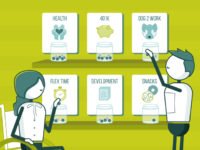Aaron Haefele’s career has been focused on helping team members develop and succeed in their roles across retail, hospitality and transportation settings. As Senior Training Director at medical transportation company MTM, he leads the creation and delivery of training to meet quality standards established by State and local laws, best practices, external and internal customers. Here, he discusses the innovative programs he’s driving to support internal and external stakeholders.
Tell us about your L+D team and tech stack.
MTM has a team of learning and development professionals dedicated to providing internal training to employees, as well as external training to stakeholders like clinicians and our networks of transportation providers and independent drivers.
We use a variety of platforms to facilitate training efforts, including:
- Percipio for annual compliance training and for some skill identification and attainment
- Talent LMS and Questbase for training drivers and transportation providers
- Articulate and Adobe Captivate for training design
- Bonfyre for enhanced team building and engagement activities
One great example of how we use our tech stack for training is our MTM competency model, which is broken into 25 capabilities. Percipio helps us identify skills aligned with each and deliver self-guided learning to help team members attain those skills. Learners complete an assessment at the beginning, receive training based on their results, and then reassess at the end to measure progress.
Tell us about your core development programs.
We have several core development programs, with onboarding being the first that every teammate experiences. Through our onboarding program, we provide training for each new employee at MTM.
Another is annual compliance. At MTM, we’ve tried to make compliance more than just a task to “check the box.” We have a comprehensive program designed to keep learners interested. This program includes activities, guest speakers, and other components, and has helped us move away from the old fashioned “show up for a day of grueling training” model that is traditionally used.
Additionally, our Leadership development program called The Bench is a year-long program in which we currently have 30 leaders enrolled. During the program, leaders progress through core learning and efforts like:
- Department overview sessions where they meet the executive leader for each MTM department and learn about their work
- A personal mentor who provides coaching and career advice during the duration of the program
- Process improvement training and exercises
- A Brand Ambassadorship where they learn what it means to represent MTM and to embody our mission and values at work
- Transformational leadership development like executive presence, gratitude challenges, vulnerability, etc.
It’s amazing to see how The Bench participants are evolving, learning, and shifting mindsets—and most of all, it’s amazing to see the results. We have experienced a more than 50% promotion rate amongst the teammates who complete the program.
What’s something new you or your team is focused on in 2023?
We have two primary focuses this year: streamlining our processes and building on success.
Technology is constantly evolving, and auditing, evaluating, and streamlining our processes is key. We’re always looking for ways to integrate systems to improve the user experience and/or reduce costs so that we can do what we do better and more effectively engage employees with learning that is exciting, interesting, and a good use of their time.
We also expanded our Bench program with a pilot called the Tech Bench, a job rotation program specific to technology. Unlike The Bench which you do alongside your day job, Tech Bench extracts a team member from their current role to spend 18 months in three to four different tech-focused areas. By the end, they will be moved into the tech area that is best aligned with their skills.
We are excited because this is building an internal pipeline of future tech leaders who really understand our organization. In this program we look for frontline individuals who may have a tech degree or some tech experience but never used it, or individuals who have shown they have an interest or passion for tech but never had the chance to explore it. We want to bring in employees who are eager to grow and are green.
What’s different about being a leader in 2023?
Employees are expecting an equitable and inclusive workplace.
They expect systems in place that make them feel included and provide clear proof that the workplace is equitable. MTM tries to be very intentional about training our leaders to know how to communicate an intentional message in a thoughtful way.
One example: in 2022, we rolled out a micro aggression training program. This is a series of six on-demand, self-guided modules that help leaders understand unconscious bias and what microaggressions look like in the workplace. We invite leaders to challenge their own conscious or unconscious biases through communication, interaction, and behavior.
Our DEI program is quite extensive through book clubs, panel discussions, and more. We recently completed a book related to mental health awareness and it created space for anyone in the organization to talk about their experiences, challenges, and biases.
Which new skills do leaders need in a more virtual work environment?
Finding the sweet spot between work from home and work in office. There is a spectrum. Some employees want to get back to the office, and others have no interest in it. Leaders need to be savvy enough to know where their employees are at and adapt accordingly.
They also must be intentional around evaluation and observation. In a work from home environment, leaders have to insert themselves a bit more and ask questions like “show me what you have going on” and “let me see you doing the work.” It can feel a little intrusive if it’s a new behavior. Communication and humility are important allies here.
They also have to be intentional about building workplace relationships and culture. Happy hours got old quick.
Leaders need new skills and resources to help them build team connectivity. Creating situations for their teams to be together and collaborate doesn’t happen by accident. It requires conscious decision and action.
We’ve been learning virtually for some time now. What’s working well? What isn’t?
MTM was running classes virtually before the pandemic, so we were well prepared for a work from home process and call center. We are operating like a well-oiled machine, and it shows in our metrics and goals!
What’s more challenging is creating situations where learners feel connected to each other, which can show up in feelings of isolation—especially with our frontline employees. It can also impact the learning process itself. For example, with new employees we hear it’s a lot to learn a new system remotely, and that anyone learning a new system wants someone next to them for that reassurance and closer guidance. You have to be so much more intentional to do this virtually.
What are the biggest challenges L&D teams are facing generally right now?
Understanding how to utilize AI in the L&D space is a big one. How do we stay relevant? As L&D professionals, we are accustomed to modifying based on the needs of the learner. This is the core of an IDP (individual development plan). Utilizing AI is a big opportunity and focus area for the L&D industry. Our trends show we’re heading in the right direction, but it’s still early.
Inflation and the economy are another challenge—ie, making sure we are right sized, scalable, and can provide the organization what is needed is an ongoing exercise.
Yet another is skills detection. Many systems today rely on self-reporting for skills, but how do we know they really have these skills? Or are these more like areas of interest?
What are some of the barriers getting in the way of adoption/engagement with self-guided learning?
Gaining buy-in is a barrier for self-guided learning. Self-guided learning historically has been thought to be dry or boring, and learners can easily fall into a “complete to check the box” mindset rather than approach learning with the goal of actually wanting to take something away from the time they spent.
For this reason, we often apply a hybrid approach to self-guided learning where we will bring groups together, explain how the journey will work, and put milestones out there for them. This helps learners see that it’s not entirely self-guided and that someone is watching progress. We are also available to answer their questions – a common negative about self-guided learning.
How do you measure the impact of leadership development after they complete a program?
Promotions and skill attainment are the metrics we monitor. Can you perform the behavior we taught you? Do we have people in the pipeline that are ready for the next level? We also look closely at the embodiment of our organizational culture through observation, metrics, and balance scorecard.
For example, in the Bench program, participants have to show up and present what they are learning, the data, and their findings. Each participant works on a process improvement project and has milestones they must produce to show us the behavior. Part of it is being able to hold executive presence and speak publicly.
What applications of AI, if any, are you seeing in the L&D space today? Or in the near future?
Right now, many organizations are starting to use AI to help with some script writing and content creation for learning assets. I do foresee that we will use AI to help with more of this in the future.
What skills are you finding relevant for leaders to help them connect with younger generations entering the workforce?
Politically, our world is a bit conflicted.
For leaders, a continued focus on cultural competency and inclusion is not optional—it’s mandatory. If leaders don’t possess cultural competency and make inclusion apparent, younger generations simply will check out and leave the organization.
They also expect leaders to understand the use of current technology and to remove barriers from doing the work the fastest way possible. Old days of leaders saying “this is how we’ve done it” doesn’t work anymore.
Younger generations also expect to be growing at work and gaining new skills. If they are just showing up to do their job every day without a clear path for advancing, they won’t stick around.



 6 min
6 min




